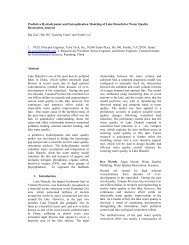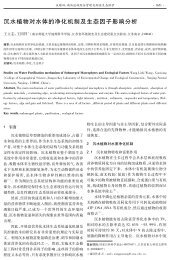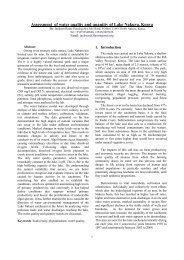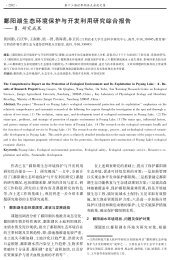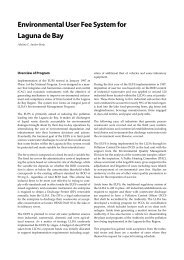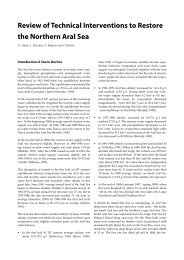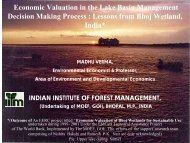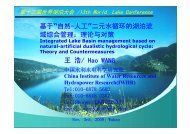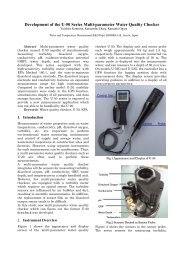Materials and methodsTo study environmental stress caused bydrought and changing water level on the fishcommunities the fish community in the reservoir wassampled on a monthly basis. Four different types ofmacrohabitat were available within the reservoir. Thefour sampling stations, A, B, C, and D are eachrepresentative for one of these four macrohabitat typesA - bottom layer of open water zone; B - pelagic zone(surface layer of open water); C - shallow intermediatezone (without vegetation); and D - littoral zone withvegetation (figure 1).Fig 1:Morphometric map of Tissawewa, withwater depths measured at a water level of4.2 m and a maximum depth of 3.3 m.Position of the sampling station areindicated on a transect from west (left) toeast (right).Sampling was carried out with four types of gear. Thedistribution of the sampling gears over the stations isgiven in Table 1.Tab 1: Distribution of sampling gears over fourstationsGear typeGill netsBottom trawlLarvae netCast netSampling stationA,B,C and DA and CB and DA,C and DFish sampled from small mesh nets (meshsizes ranging from 12.5 to 37 mm stretched mesh) wereused for gut content analysis to determine feedingbehaviour of fish. Small mesh nets were set at 0600hours and lifted at 0800 hours for day-time samplingwhile for the night time sampling setting time was1800 and lifting time was 2000 hours. To preventdigestion of gut contents small mesh size nets werekept only 2 hrs in the water. Since the feeding habitsand behavior of the fish species depend on the size ofthe fish, each species was divided into six lengthclasses. The six length classes and their respectivelengths are given in Table 2.Fish were brought into the laboratory fordetailed analysis and in the laboratory emphasis was ongut content analysis, gut fullness. For gut contentanalysis the percentage of the biovolume per fooditems were used. This is the modified point method ofHynes 7 .Maximum of contents of ten stomachs or first1/3 of the alimentary track (for stomachless fish) persize group per species per station was pooled and thissample was subjected to gut content analysis.Following categories of food item was identified.Animal food organisms: fish, shrimp, adult insects(aquatic or terrestrial), insect larvae (mainlychironomids, chaoborus and others), mollusc(gastropods and bivalves), zooplankton (copepodscladocereans and rotifer), microbenthos (harpactocoids,cladocerens and ostracods), and poriferons spicules.Plant materials consisted of: macrophytes, filamentousalgae (benthic and planktonic), other phytoplanktonand pollen and seeds. Digested matter or/and detritusand an organic materials were also recorded.Tab 2: The six length classes and their respectivelengths.Length classesL1L2L3L4L5L6Total length (cm)3.0 - 4.44.5 - 6.97.0 - 9.910.0 - 13.914.0 - 18.9> 19.0Diet overlap (S) between each pair of speciesand any two size classes of particular fish species wasdetermined using Schoener’s 8 formula;S = 1- 0.5 (S ai=1 n ½P xi -P yi ½).Where S is the dietary overlap coefficient of fishspecies x and y, P xi is the proportion of food category“i” in the diet of species “x”, P yi is the proportion offood category “i” in the diet of species “y”, and n is thenumber of food categories.The values for this similarity index range from0.00 to 1.00, with 1.00 indicating complete overlap and0.00 indicating no overlap. The similarity indices having
values less than 0.33 were considered to indicate a lowoverlap while the values above 0.67 were considered toindicate high overlap 9 .The niche breadth was calculated for each fishspecies using the niche breadth coefficient, b i 10 .b i = -S n j=1p j * log pj.Where p j is the proportion of food category “j”consumed by species “i”, b i is the niche breadthcoefficient of a fish species “i”, and n is the number ofresource states available.Diet overlaps were calculated on basis of the gutcontents of species, length classes per species,sampling stations and for two hydrological periods i.e.pre drought period and post drought period. For thedata analysis SPSS (ver 10) statistical package wereused. Spatial, temporal and size related feedingbehaviour relate to gut contents was investigated usingANOVA.ResultGut/stomach contents of co-occurring fish speciesin Tissawewa irrespective to sampling station, fishingtime, fishing gear, and length class of the fish wereshown in Tab 3.Amblypharyngodon melattinus (AM) highlydepend on detritus matter and algae (seston), and assuch, can be classified as a member of thedetritivorous/herbivorous feeding guild. Oreochromis.mossambicus (OM) and Oreochromis. niloticus (ON)and Tilapia. rendalli (TR) mainly feed on macrophytes,algae and detritus, and therefore belong to the samefeeding guild. Barbus. chola (BC), Barbus. dorsalis(BD) and Barbus. sarana (BS) mainly feed on, benthicand insect matter and this three fishes represent thebenthivorous feeding guild. Gut contents of theGlossogobius. girius (GG), Channa. striata (CS) andMystus (MYS) species showed a high percentage of theprey fishes and therefore these fish species representthe piscivorous feeding guild. Hyporamphus. gaimardi(HG) and Rasbora. daniconius (RD) represented thezooplanktivorous feeding guilds.Dietary overlapThe similarity indices of the diets among thedifferent species studied are shown in Table 4. Of the66 possible species pairs 13 (» 20%) showed highoverlaps and 5 pairs (» 7.5%) showed low overlapvalues in diet. High overlap values were observed forspecies pairs belong to the same feeding guild, andcontrary low dietary overlap values were observed inspecies pairs of far different feeding guild i.e.detritivorous and piscivorous. Highest dietary overlaps(0.92) were observed for species pairs of OM-ON andHG-RD. pecies pairs belonging to the detritivorousfeeding guild and to the piscivorous feeding guild, withthe exception of the species pairs of MYS-CS and CS-GG, displayed high dietary overlap values (³ 0.80).Species pairs of AM- CS displayed lowest dietaryoverlap value (0.17).Tab 3: Gut/stomach contents of co-occurring fish species in Tissawewa irrespective to sampling station, fishing time,fishing gear, and length class of the fish. Letters on top of bars indicate significantly different groups recordedfrom student-newman-keuls test. Similar letters indicate non- significantly different groups. Abbreviations usedfor fish species are Amblypharyngodon melattinus (AM), Barbus. chola (BC), B. dorsalis (BD), B. sarana (BS),Channa. striata (CS), Glossogobius. girius (GG), Hyporamphus. gaimardi (HG), Mystus (MYS), Oreochromis.mossambicus (OM) O. niloticus (ON), Rasbora. daniconius (RD) , Tilapia. rendalli (TR). Abbreviations usedfor food category are Shri: Shrimp, Inse: Insect matter, Mollu: Mollusc, Zoop: Zooplankton, Micro:Microbenthos, Macr: Macrophytes, Pori: Poriferan spicules, P/S: Pollen and seeds, Di/<strong>De</strong>: Digested and detritusmattersfood itemsfish species fish shrimp insects mollu zoop micro macr algae pori p/s di/deAM a 0.00 0.00 0.71 0.00 3.28 0.09 0.38 18.95 0.04 0.07 76.49BC b 0.00 0.00 24.29 3.08 9.25 15.47 2.10 0.59 0.56 2.07 42.60BD b 0.00 0.00 36.06 12.13 6.55 12.87 1.03 0.62 0.14 2.06 28.53BS b 3.75 0.00 19.74 34.34 3.39 1.71 5.71 1.86 1.39 1.29 26.82CS c 53.40 0.00 30.50 0.00 0.10 0.00 0.60 0.50 0.00 0.00 14.90GG c 31.60 3.13 24.11 0.43 5.18 1.61 0.64 0.02 0.01 0.05 33.21HG d 0.00 0.00 16.20 0.00 38.74 0.17 10.78 1.14 0.08 0.00 32.89MYS c 16.88 0.30 25.24 0.17 18.95 1.32 0.85 0.81 0.08 0.17 35.23OM e 0.33 0.00 4.28 0.00 5.62 0.42 3.99 23.78 1.85 0.16 59.56ON e 1.19 0.00 1.23 0.00 3.58 0.02 11.99 18.86 2.61 0.00 60.52TR e 7.30 0.00 4.73 0.00 2.11 0.00 27.78 7.86 10.41 2.16 37.65RD d 0.00 0.00 22.40 0.11 37.85 0.44 2.56 1.75 0.04 0.08 34.77



